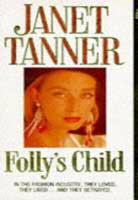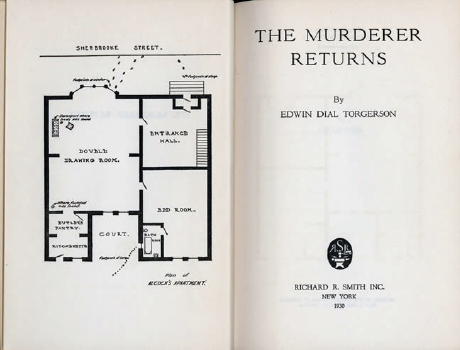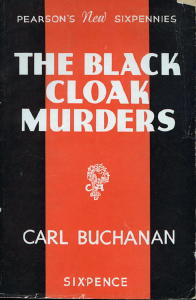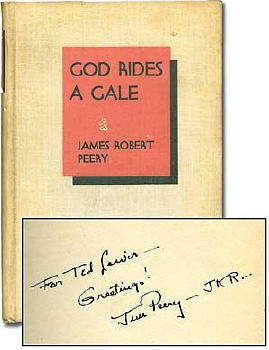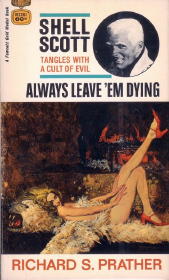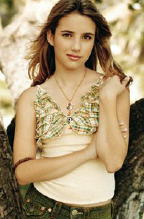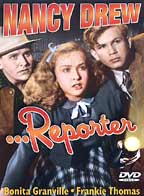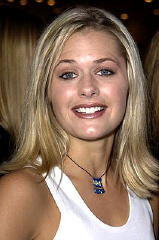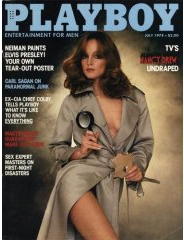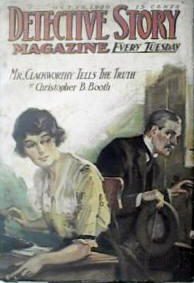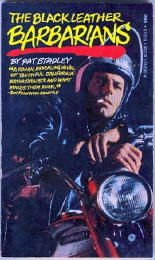January 2007
Monthly Archive
Mon 15 Jan 2007
I don’t know the true protocol for this, having only been a blogger for just under three weeks, but I’d like to re-post some of the comments that I’ve received on my checklist of Real Estate Detectives. If I don’t do it this way, I have a feeling that they’ll fall through the cracks, and people who’d enjoy reading them might not otherwise. (From my own personal experience, I read the comments when I read someone’s blog entry, but I never go back and see if anyone’s commented later.)
First, from author Lou Allin:
My realtor sleuth Belle Palmer lives in the Nickel Capital, Sudbury, Ontario, and specializes in cottage properties, which lets her roam around the bush at will. As mentioned earlier, there are four books in the series,
Murder, Eh? being the latest. In that novel, I finally got around to letting Belle find a body at a house showing. For that, I earned a mention on a strange website called “Bathtub murders in Toronto.” The next entry in the series may be titled
Dial Belle for Murder. Selling houses is an ideal job for an amateur sleuth because she’s always coming in contact with new people…often with secrets to hide.
My reply:
Then from author Nina Wright:
Hi, Steve. Thanks for mentioning Whiskey Mattimoe, my Realtor turned amateur sleuth. I agree with Lou Allin; a career in real estate offers our protagonists access to the private lives of many fascinating strangers. Moreover, since choosing a place to live is an expensive and emotional decision, high stakes are already in place.
My humorous series is set in Magnet Springs, Michigan, a fictional tourist town across the Lake from Chicago. In addition to a cast of artistic and eccentric regulars, Whiskey encounters affluent vacationers who pack their dark sides when they leave home.
Another perk of the Realtor protagonist is her legitimate excuse to snoop (a little). Since I’m personally fascinated by architecture and home design, one of the promises I make to my readers is that Whiskey will find herself inside at least one uniquely fascinating property per book. I enjoy concocting those details as much as the gourmet mystery writers probably savor their recipes.
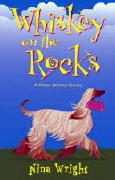
My reply, which is now the last one posted, but it also contains a short response from Lou Allin:
To both Lou and Nina,
I believe that you’ve pointed out something essential in each of your posts. The biggest problem in maintaining an amateur detective as a continuing character is how do you (believably) make sure that your detective keeps coming across murders to solve?
At first I was surprised at the large number of realtor-sleuths that turned up. Now I’m wondering why there aren’t more of them!
>>> Lou’s email reply to me:
Hi, Steve
One cliche I avoid (selective memory privilege) is having people comment to the sleuth, “Oh so you’re the one who keeps finding bodies. Any luck lately?” or some such. We all know that even police detectives don’t normally work on murder after murder (well, maybe in New Orleans or L.A.).
If readers want amateur sleuth mysteries, they’ll agree with the willing suspension of disbelief.
Lou
Sun 14 Jan 2007
John Herrington is one of the more prolific contributors to the continuing flow of Addenda to Allen J. Hubin’s Revised Crime Fiction IV. He describes his recent activity as follows:
“What I am doing, out of ennui after Christmas, is going through
CFIV at random and picking out authors, with a handful of titles or more, whom Allen has yet to find any information on – then googling them. Slow old business as for every name I find something, there are a score or more that remain anonymous.”
The information that follows arrived in a recent email to Al. To provide the proper context, I’ve included the full entries for each of the authors as they presently stand in CFIV, with John’s comments following:
TINSLEY, REBECCA
* * *The Judas File (Headline, 1995, hc) [Charlotte Carter; Ireland]
* * *Settlement Day (Headline, 1994, hc) [Charlotte Carter; London]
This lady is a journalist, having written in
New Statesman,
Times,
Telegraph etc., and once worked for BBC. Very involved in Humans Rights according to Internet references to her. But no date of birth.
TANNER, JANET
* * *Daughter of Riches (Century, 1992, hc) [Australia] St. Martin’s, 1993.
* * *Deception and Desire (Century, 1993, hc) St. Martin’s, 1995.
* * *Folly’s Child (Century, 1991, hc) St. Martin’s, 1992.
Janet Tanner has written all her life, hundreds of short stories published worldwide before she turned to novel writing. No date of birth. though she is a grandmother with young grandchildren.
TORGERSON, EDWIN DIAL
* * *The Cold Finger Curse (U.K.: Falcon, 1933, hc) [Sgt. Pierre Montigny; New York City, NY]
* * *The Murderer Returns (Lane, 1931, hc) [Sgt. Pierre Montigny; Montreal, Canada] Smith, 1930.
Found at the website for the
Archives Collections at the University of Mississippi:
“The son of a Swedish-immigrant architect, Torgerson was born in Meridian, Mississippi in 1896 and spent part of his early childhood in Oxford. After graduating from high school, he worked for a number of newspapers and edited Hearst’s American Weekly. Torgerson also wrote short stories that appeared in well-known periodicals, including several detective tales. His first full-length novel, The Murderer Returns, takes place in Montreal, Canada. The principal clue is a set of paw prints left in the snow by a cat. In 1937, he moved to Hollywood after MGM invited him to write a screenplay based on one of his mysteries, and he died there the following year.”
From The FictionMags Index, the following magazine short stories (an incomplete listing):
TORGERSON, EDWIN DIAL
* * The Challenger, (ss) McCall’s Jul 1937
* * Heart and Carrots, (ss) McCall’s Nov 1931
* * High Game, (ss) Argosy Dec 31 1938
* * No Questions Asked, (ss) Detective Story Magazine Apr 8 1919
* * One-Horse Bank, (ss) The American Magazine Feb 1936
* * The Second-Seer, (ss) Argosy Sep 13 1919
* * Uneasy Money, (ss) The American Magazine Mar 1935
From the same University of Mississippi website comes the first discovery of the year. I’ll begin with the present
CFIV entry:
BUCHANAN, CARL
* * *The Black Cloak Murders (Pearson, 1936, hc) [North Carolina]
* * *Night of Horror (Mellifont, 1939, pb)
* * *The Red Scorpion (Mellifont, 1939, pb)
“Carl Buchanan was the pseudonym used by James Robert Peery on
The Black Cloak Murders published in London by C. Arthur Pearson, Ltd. in 1936, with later translations in Spanish and Danish. Set in the southern United States, a murderer seeks information concerning a treasure buried in Europe at the end of World War I. Peery was born outside Stewart, Mississippi in 1900 and grew up in Eupora. During World War I, he served in the U.S. Army’s Signal and Intelligence divisions. Once home, he worked in banking and cotton before settling into journalism. Pulp magazines accepted several pot-boilers submitted by him under a penname. Peery reserved his real name for two literary novels that appeared in 1938 and 1940.”
Again from The FictionMags Index:
BUCHANAN, CARL
* * The Crag Island Murders, (nv) Five-Novels Monthly Apr 1932
* * Crimson Goblet, (ss) Clues Aug 1934
* * Finger for Sale, (ss) Clues Oct 1935
* * Laughter in the Chapel, (ss) Clues Apr 1934
* * The Mystery of the Two Glasses, (ss) Clues Jul #2 1930
* * Red Haven, (ss) Clues Dec 1934
* * Rhapsody in Blood, (ss) Clues Feb 1934
* * Right Guy, (ss) Clues Aug #1 1930
* * Screams of the White Cockatoos, (ss) Clues Jul 1934
* * Sweet Racket!, (ss) Clues May #2 1930
* * The Time of the Crime, (na) The Thriller Dec 9 1933
* * 2 Minutes from Murder, (ss) Clues Mar 1935
[Steve again.] One of the books published by James Robert Peery under his real name is God Rides a Gale (Harper & Brothers, 1940). Curiously, the ABE seller who has a copy of this book describes it thusly: “Inscribed by the author: ‘For Ted Lewis – Greetings! Jim Perry – JKR.’ The second of two literary novels by this Mississippi-born author, who also published mysteries with a co-author under the pseudonym Carl Buchanan.”
Peery’s first literary novel does not appear for sale on the Internet, nor at present is there an entry for James Robert Peery in CFIV. Al Hubin says: “I’ll add brief notes to the Tinsley and Tanner entries (in Addenda #9); the Torgerson information is pretty well what I have in the Revised CFIV. But the Peery info (along with his 1954 death date) will go into #9 with pleasure.”
Online presently are Addenda installments 1 through 8. Look for Part 9 shortly.
[UPDATE: 01-22-07] Taken from an email sent by Victor Berch:
Steve:
To Carl Buchanan’s repertoire, you can add the following:
Blind Trail, All-Star Detective Stories Oct. 1930
The Head That Lived, Super Detective Stories July 1935
Hot Car Wreckage, All-Star Detective Stories Apr. 1932
The Monk’s-Hood Murders, All-Star Detective Stories July 1930
Murder By Candlelight, Mystery Apr. 1933
Murder in the Rain, The Underworld Magazine Aug. 1931
The Red Scorpion Murders, World Man Hunters Feb. 1934
Rope’s End, Murder Stories Sep-Oct 1931
There was one other tale under the name Robert Peery, who, I assume, is our man:
The Spy Champion, Startling Detective Stories Mar. 1930.
>> Thanks, Victor. I’m inclined to agree with you about that last story. –Steve
Fri 12 Jan 2007
I just received an email from Linda Pendleton, widow of crime fiction writer Don Pendleton, telling me about an interview she did late last year with Richard S. Prather, now 85 and most well-known as the creator of private eye Shell Scott, whose wacky capers in the 1950s, mostly for Gold Medal, kept kids (teen-agers) like me turning the pages as quickly as they could.
The interview is online as part of her own website. It’s a long one, and it goes deeply into both Prather’s writing techniques and his philosophy of writing as well as his views on life itself.
What I’ll do is tease you with some of the questions. You’ll have to read the interview to learn what Prather’s answers were.
Linda: The first Shell Scott novel, Case of the Vanishing Beauty was published in 1950 and your long career was off and running. Was that your first publication or sale of your work? Did you have an agent for your first sale?
Linda: You have had a number of short stories published almost from the beginning of your career. Have you enjoyed writing short stories as much as novels?
Linda: Let’s talk about the creation of your Shell Scott character. Obviously, with the number of books you have written in the Shell Scott series, and the huge success you achieved, there must be special qualities about him as a protagonist that stay with your readers. Many fans have found your stories to be full of humor and some fans even refer to them as hilarious. As the creator of Shell Scott, what do you consider to be the essence of Shell Scott? What qualities did you give him as a character that made him outstanding and appealing to readers? I assume he “grew” during the years of writing the series. In other words, how did his world view evolve from his “younger” days?
Linda: You’ve been one of the lucky authors who was able to have a solid career and write full time. And I know you had the support of your beautiful wife, Tina, throughout those years. Having lost Don, I personally know how difficult it has to be for you since Tina’s death two years ago, and after 58 years of marriage. You very well may hold the record for the longevity of marriage for a writer! I understand Tina helped you with your work, such as suggesting that good book title you just mentioned—and typed, and I would imagine gave you some critical appraisal of manuscripts from time to time. Writing can be such a lonely endeavor as we are sequestered with our fictional characters, sometimes for long periods of time. How important was it to you, and to your relationship, that she was so supportive throughout the years?
Linda: Don had Executioner cover art by artist/illustrator, Gil Cohen on many of his books, who captured the essence of Mack Bolan. You mentioned many of your Gold Medal editions cover art was done by well-known illustrator, Robert McGinnis, and he just did the cover for your recent reissue release of The Peddler — and, by the way, the cover looks very nice. Obviously, McGinnis’ illustrations of beautiful sexy women on the covers of your books may have caught the attention of book buyers. I understand you wrote an Introduction to The Paperback Covers of Robert McGinnis by Art Scott, published in 2001. You covered some of this already, but again, how important do you feel cover art is for the sale of a book? Did you have any influence on cover design on your novels?
Linda: Richard, here it is at the end of 2006 and you are now eighty-five years of age. What are your thoughts on the technological and scientific advances you’ve seen in your lifetime?
Linda: I understand you have a Shell Scott unpublished manuscript, The Death Gods, of 1,000 pages. What are your plans for this novel?
Richard: Ah, yes. The Death Gods. You’re right, Linda, I do have that 1,000-page manuscript here. It’s …
Richard S. Prather – Bibliography
Don Pendleton – Bibliography
Fri 12 Jan 2007
Here’s the entry for her as it presently appears in Crime Fiction IV, by Allen J. Hubin:
STONE, ELINORE COWAN (1884-?) Born in Michigan, raised in Pittsburgh and Boston; newspaperwoman, teacher, magazine short story writer; living in Pittsburgh in 1930s.
* * *Fear Rides the Fog (Appleton, 1937, hc) [Pittsburgh, PA]
The entry is not impressive in itself, but the biographical notes added by Al suggest that there was more to her life than the one mystery novel. What’s nice to be able to do, when it can be done, is to discover the story behind the story, as it were. To that end, the following, which was sent to me by Al a day or so ago, does exactly that.
Article from unnamed newspaper, dated Thursday, March 22, 1973:
90-Year-Old Couple Enjoys Life By Jan Rider
Today is the 90th birthday of Mrs. Elinore Cowan Stone, Morehead City [North Carolina]. Mrs. Stone has been upset since she lost her wedding ring several months ago. She cannot figure out when, where or how she could have lost it. It is a ring she has worn since June 7, 1915. Today her husband, C.A. Stone, who was 90 years old last month, gave her a new ring. Of course it cannot replace the old one completely, but it is the thought that counts.
Mr. and Mrs. Stone have been married almost 58 years. They have been residents of Morehead City for 19 years. The Stones have a long and happy history. Mrs. Stone does point out, however, that they have not been totally happy. “Nobody can be totally happy. We have been mad as hell at one another at certain times.”
The Stones have enjoyed life. They have traveled and they have both been blessed with good health. Mr. and Mrs. Stone met at the University of California, Sacramento, when they were doing graduate work. “I really can’t remember exactly where we met,” Mrs. Stone said. “It was in an English class. The professor was a real wit,” interjected Mr. Stone. “Don’t you remember? His name was Smith, I think.” “I don’t remember him,” Mrs. Stone said, “But I remember you, so what is fame?”
The Stones came to Morehead City from Pittsburgh, Pa. They had lived there longer than anywhere else, 30 years. They came to Morehead City because of the Chamber of Commerce. When Mr. Stone was planning his retirement, Mrs. Stone wrote to the Chambers of Commerce in numerous towns asking for information concerning the cost of living and facilities in the town. “Morehead City was one of the few towns that sent us any information,” said Mr. Stone, “We liked it the best and moved here in 1954.”
Prior to their marriage, Mrs. Stone taught school in Honolulu. There she developed her interests in drama. She coached several plays during her stay, one of which was “As You Like It.” After their marriage, the Stones lived in California for awhile. They enjoyed the mountains and spent many days camping and scouting the wilds of California.
Later the Stones moved to the Midwest. While there Mrs. Stone continued her teaching. She first taught in a small one-room school on an Indian reservation in New Mexico. Her experiences there are recorded in her first novel, “The Laughingest Lady,” which was published in 1927. The book’s title, Mrs. Stone says, was the name many of her Indian pupils called her. “I don’t think they had ever met anyone like me before. I was always joking and enjoying myself.”
In a faded picture album, Mrs. Stone pointed out pictures of herself and several of her students standing in front of their mud dwellings. Later in the Midwest, Mrs. Stone taught in a one-room school on a large ranch. In 1934 the Stones moved to Pittsburgh when Mr. Stone, an employee of the Navy’s Quality Control department, was transferred. In Pittsburgh Mrs. Stone wrote a column for a local newspaper and continued her writing. While in Pittsburgh, Mrs. Stone published her second book. The book, entitled, “Binks, His Dog and His Heart,” was a children’s story. It was published in 1937. In that same year she also published a mystery novel entitled “Fear Rides the Fog.”
Also published during this same time period were numerous short stories, two of which are included in the “O. Henry Memorial Award” volumes. As Mrs. Stone became more involved in her teaching and her column, written for a Pittsburgh newspaper, her books and short stories became fewer.
Mr. and Mrs. Stone agree that life in Morehead City has been good for them. They have grown to love the area, the people and especially the sea and the salt breezes. Occasionally they will drive over to the beach and walk along the oceanfront. Since Mrs. Stone fell and broke her hip about 10 years ago, their walks have been limited to the board walk area. She is unable to walk safely on the loose sand. On most evenings the Stones can been seen walking around the Camp Glenn school grounds. They enjoy the exercise and fresh evening air.
What do two people 90 years old do all day? “Well, to be honest, we sleep much of the time,” said Mr. Stone. “He watches that thing,” said Mrs. Stone, pointing to the television set. “I can’t stand the cackling voices.” “She doesn’t hear too well any more,” said Mr. Stone. “I hear too well,” said Mrs. Stone.
It is obvious to anyone visiting their home that the Stones do more than sleep or watch television. Two walls in the living room are lined with books. On the shelves are the complete works of Dickens, Kipling, Shakespeare, and Buck. On the side table on top of a recent news magazine is a large magnifying glass used for reading. Numerous volumes of Reader’s Digest Condensed books are noticed and to complete the room are several reading lamps. This world, sometimes referred to as “cold and cruel,” has been warm and gentle for Mr. and Mrs. Stone, probably because they are warm and gentle people.
Here’s Al’s followup note:
It appears CFIV is one year off on her birth year (should be 3/22/1883, if the article is correct). I’ll now see if I can track down a death date, now that I have that date and know that they were last living in Morehead City, North Carolina.
[Later] I’ve found her record in the social security death benefits. And this gives her birth as 3/22/1885 (and death in November 1974). Looks like the article was premature in calling her a 90-year-old … and she didn’t quite make it to that milestone, as it turns out, though her husband did.
Obituary from The News-Times, Morehead City, Beaufort, NC, Thursday, Feb. 1. 6, 1975, pg. 9-A:
Clarence A. Stone. A memorial service for Clarence Stone, 91, Morehead City, was conducted at 4 p.m., Wednesday in St. Andrew’s Episcopal Church. He died Tuesday in Carteret General Hospital. The Rev. King Cole, rector, officiated. Mr. Stone has no immediate survivors.
>> As of 11:30 this morning, no copies were found of Mrs. Stone’s mystery novel offered for sale on the Internet. About five copies of The Laughingest Lady were found. About one the seller adds: The name “Irene L. Cowan” is on the flyleaf (possibly related to the author?).
The short story “The Devil-Fish, by Elinore Cowan Stone, appears in A. Merritt’s Fantasy Magazine, October 1950. Probably a reprint. [See UPDATE 01-25-07]
From The FictionMags Index, here is a partial list of her other stories:
* * All in the Day’s Work, (ss) The Century Sep 1927
* * Be My Valentine, (ss) Woman’s Home Companion Feb 1927
* * The Gritty Little Devil, (ss) The American Magazine Jul 1930
* * Hands Off, (ss) McCall’s Nov 1931
* * Leetla Dog, (ss) Woman’s Home Companion Jul 1925
Also, from Good Housekeeping, February 1926:
“Lonch [sic] for Two” by Elinore Cowan Stone is a short story dealing with the “Americanization” of Hispanic children.
O. Henry prize-winning stories:
1925. Elinore Cowan Stone: “One Uses the Handkerchief” Women’s Home Companion, November 1924.
[UPDATE 01-25-07] Victor Berch did some further investigating into the life of Mrs. Stone, and the results have been posted as a separate entry. Besides uncovering evidence that she was born in 1883 and not 1885, as the Social Security records show, Victor has also added a large number of stories to her bibliography. These should be added to the ones above.
In terms of the story “The Devil-Fish,” a cry for assistance from the members of the Yahoo FictionMags group produced the following response from Ned Brooks:
“I have a copy of that — it’s an seven and a half page story with a full-page Finlay illo. The ToC blurb is mysterious and seems too complex to be covered in 7.5 pages: “Could Salisbury’s medico-science-filled world find a way to bring him back from the embrace of a civilized savagery?” It has to do — from a quick scan — with a not altogether successful attempt to remove a whole-body tattoo.
“There is indeed prior copyright information. On both the ToC (under the blurb) and on the bottom of the title page of the story itself (p.92) there is the line —
“Copyright 1926 by Popular Publications, Inc.” The editorial, which runs about a page, discusses George Allan England and Jack Williamson (who have the novel and novelette in the issue) and the contents for the next issue — which never appeared, as this is the last of the five existing issues. No mention of Elinore Cowan Stone there. The Miller/Contento CD-Rom I have knows no more, listing the A. MERRITT printing and the earlier one but with no magazine title given. The attribution to “Popular Publications” is probably incorrect — according to PulpWiki anyway, Steeger founded Popular Publications in 1930.”
Thanks, Ned. My instinct was correct. It’s highly unlikely that Mrs. Stone would have stopped writing in the 1920s only to write a single fantasy story 20 or more years later. I’m not too concerned about the copyright date, assuming that when Popular bought out a magazine that had folded, they transferred all of the copyrights along with it. The question remains, however, which presumably non-genre magazine in 1926 was it that the story first appeared?
[UPDATE 01-27-07] From a posting by Mike Ashley on the Yahoo FictionMags Group, the answer is now known. He said, and I quote:
“The Devil-Fish” by Elinor Cowan Stone first appeared in Argosy [All-Story Weekly] for 6 March 1926.
And from Ned Brooks again, a description of the story itself —
No particular reason the story had to be in an SF pulp, it isn’t that skiffy and the borders were a lot fuzzier then anyway. The only skiffy element is that a way to remove a tattoo had been discovered. I think they use lasers now, but removing a full-body tattoo would still be arduous and expensive. The system failed in that when the fellow blushed, the “devil-fish” (a squid or octopus) reappeared in red on his forehead.”
Thu 11 Jan 2007
I recently read and reviewed an obscure one-shot mystery from the 1950s in which the amateur detective was also newly hired as a real estate seller. In fact the murder occurred during a open house she was holding. The book was Held Open for Death, by Evelyn Payne (Arcadia House, 1958), in case you were wondering, and if you’d like to read the review, here is where you may.
What I wondered out loud when I wrote the review was how many other real estate agents can you think of who’ve been called upon to solve mysteries over the years, either as a series character or as a one-shot deal?
I also asked the question on DorothyL, and while some of answers were obvious ones, the people who hang out there know their stuff. Several of the responses were of authors and characters I’d never have come up with on my own, no matter how long you’d left me to do so, nor how many reference books I had access to.
The first reply was from Debbie Bogenschutz:
Tierney McClellan (pseudonym for Barbara Taylor McCafferty) wrote a real estate series in the 1990s:
Two-Story Frame
Closing Statement
A Killing in Real Estate
Heir Condition
Charlaine Harris had a series featuring a librarian Aurora Teagarden whose mother (a regular character) was a real estate agent. The Julius House and Three Bedrooms, One Corpse had more real estate aspects, as I remember.
The realtor-detective in the McClellan books was Schuyler Ridgeway, described online, where I immediately went to look her up, as “feisty” and “spunky.”
From the plot outlines of the Teagarden books, of which there are seven, Three Bedrooms, One Corpse appears to be the one most closely related to the real estate business: “Basking in an inheritance that makes her financially independent, Roe’s looking for a new occupation. Her days as a librarian are over. Real estate might be fun, she thinks. And who better to teach her the tricks of the trade than her Lauren Bacall look-alike mother, Aida Brattle Teagarden Queensland, who happens to own one of the major real estate firms in town?”
Go here for plot summaries of all of Aurora�s adventures in solving murders.
The next email was from John McFetridge:
Hi Steve,
I saw your post on DorothyL. I can’t think of any real estate agent sleuths, but my first novel was published in 2006 and the main character is a real estate agent named Roxanne Keyes. She witnesses a murder, doesn’t tell the cops she recognized the killer and tries to blackmail him. Still, I don’t see her as the bad guy.
The book’s called Dirty Sweet. You can get more info here: www.johnmcfetridge.ca
Good luck,
John
The book doesn’t exactly fit the “cozy” profile I had in mind for the category, but I certainly agree that it fits the category. Thanks, John, and good luck with the book.
John’s reply:
Thanks for your interest.
Dirty Sweet is available as a hardcover from Amazon now. My Canadian publisher has just sold the trade paperback rights to a US publisher, but the deal hasn’t been announced yet.
I had fun doing the real estate research for my book. I got to use phrases like “shadow vacancies” and “off-market deals.”
John
From Diana Vickery, an email brief and to the point:
Ben Abbott in Justin Scott’s mysteries.
Ben Abbott is described online as a small town Connecticut real estate agent and private investigator. There are four in the series, including McMansion, which came out only last month. The three earlier ones are:
HardScape
StoneDust
FrostLine
I know of these books, and I haven’t read any of them. What with the private eye aspect of the character and the small town Connecticut setting, I don’t know why. I will make it a point to definitely do something about that. (And more about Justin Scott in an upcoming post, if all goes well.)
PS. Check out Diana’s Cozy Library website. It is what it says and more. The reviews, most if not all of them written by Diana, are both informed and informative.
Posted on DorothyL was this response from Bente Gallagher:
Maggie Sefton has a book called, I think,
Dying to Sell. Nina Wright writes the Whiskey Mattimoe series —
Whiskey on the Rocks, etc. — and Tierney McClellan/Barbara Taylor McCafferty writes about Schuyler Ridgeway, a realtor in Louisville, KY.
The first line of Maggie Sefton’s Dying to Sell reads this way: “In Fort Collins, Colorado Shamrock Realty realtor Kate Doyle detests having to sell the home of friends, attorney Mark and Amanda Schuster, who have filed for divorce.”
When Mark is murdered, Amanda is suspected. While Maggie Sefton has written three “Knitting Mysteries,” this is the only “Real Estate Mystery” listed on her website. Beth Groundwater mentioned the same book.
A description of Nina Wright’s books: “The humorous Whiskey Mattimoe mystery series is set in the scenic Lake Michigan resort town of Magnet Springs. Suddenly widowed at age 33, realtor Whiskey Mattimoe finds herself saddled with her late husband’s diva dog, Abra the Afghan hound, who has the unfortunate and felonious habit of stealing purses. That’s bad for business but not as bad as having clients die on site. A string of deaths at properties that she manages forces Whiskey to solve murders in order to stay solvent.” At present (or soon), there are (will be) three books in the series, with one more on the way:
Whiskey on the Rocks
Whiskey Straight Up
Whiskey and Tonic (June 2007)
Whiskey and Water (in progress)
Check out the author’s website for more information.
Today on DorothyL, the following message was posted by Caroline Craig:
Someone asked about real estate agents and I don’t recall anyone mentioning Belle Palmer, Lou Allin’s Canadian sleuth/real estate agent. I love Belle and her friends and can’t let them miss the list. 🙂
Absolutely. From the author’s website, there are four books in the Belle Palmer series:
Northern Winters Are Murder
Black Flies Are Murder
Bush Poodles Are Murder
Murder, Eh?
The “middle-aged” Belle is a realtor who lives in northern Ontario, which helps to explain the titles. Based on online descriptions, it is difficult to say how much of the real estate business is involved in each one of the books, but a realtor is what she is.
And as of today, this is where the checklist stands. Thanks to all who’ve contributed, and if you can come up with any that I’ve missed, then by all means, let me know.
UPDATE: Later the same day. I am not sure how or why things like this happen, but they do. My monthly shipment of Worldwide Mysteries arrived from Harlequin today, and one of the three was … Maggie Sefton’s Dying to Sell. Maybe that means I am destined to read it, and I think I shall. By the way, you can only get the Worldwide books by subscription and through the mail now, is that so? You can’t buy them in stores? This paperback edition isn’t even listed on Amazon.com.
Wed 10 Jan 2007
Posted by Steve under
CharactersNo Comments
Leafing through today’s Wall Street Journal this evening, I spotted an item that was — sure enough — mystery related. (You have to know where to look.)
Due in theaters on June 15th is, if I am reading it correctly, a big-screen adaptation of Nancy Drew, girl detective. Other than mentioning that Emma Roberts, 15-year-old niece of Julia Roberts, will be playing title role, details are skimpy in the WSJ piece, but among other things, they do mention Nancy’s debut in the 1930 hardcover novel, The Secret of the Old Clock; the Warner Brothers series of movies made in the late 1930s (with Bonita Granville); and a made-for-TV version in 2002, “originally intended as a pilot, that didn’t attract much of an audience.”
I missed that one completely. I don’t remember it at all. But with www.imdb.com available to extend a helping hand whenever something like thus happens, I can tell you more. It starred Maggie Lawson as Nancy and was part of ABC’s The Wonderful World of Disney program, which goes a long way in explaining why I never heard about it until now.
One person who commented on the film said: “The acting has a three-second delay, and consists of making faces and striking poses.” Not good. But more recently Maggie Lawson seems to have found a home on the USA Networks’ Psych, as new, young (and very blonde) police detective Juliet O’Hara.
Strikingly, and I do not know for what reason, the piece in the Journal does not mention Pamela Sue Martin. Now that was a series (1977-79) I do remember.
Wed 10 Jan 2007
Hi Steve
Can you tell me whether your MR. CLACKWORTHY volume from Wildside contains any tales not collected in the two Chelsea House volumes of the 20’s? I have one of them but not the other.
Best wishes for 2007.
Doug Greene
>>>
This may be more than the rest of the world wants to know, but after I wrote a review of the first Mr. Clackworthy collection, word got around, and I somehow became known as the expert on the character, who was created by Christopher B. Booth and who first appeared in a long series of stories for Detective Story Magazine. Little did anyone know that the stories in Mr. Clackworthy (Chelsea House, 1925) were all that I knew about the fellow, a gentleman con man who preyed on unscrupulous bankers, stockbrokers and other chiselers, thereby striking a certain chord in the hearts of thousands of readers in the Depression era. The stories were quite popular.
But the limited knowledge that I had certainly did not prevent me from being asked to provide the introduction to the recent Wildside collection of Clackworthy adventures — nor prevent me from accepting for that matter, either.
Which of course obliged me to not completely fake it. Even after the Wildside book was published, I continued to hunt around to find as much information as I could come up with. I have the first and third of the three volumes below, but not the second. The stories in the first of the two Chelsea House books are not identified by name. It’s what’s called a fix-up novel: a collection of stories combined into what is called a novel, but is, simply speaking, a collection of stories combined into a novel, some related to each other, others not.
I suspect, but do not know for sure, that the second Chelsea House collection is structured the same way. For the titles of the stories in both books, I am indebted to Gordon W. Huber’s Chelsea House: A Bibliography (June 2001), with the relevant data sent on to me by Don Davidson. For the first book, I matched the story lines with the titles that Gordon listed, his data coming directly from the Street and Smith files located at Syracuse University. (Street and Smith was the publisher of Detective Story Magazine, among tons of other pulp magazines and dime novels over the first half of the past century.)
THE MR. CLACKWORTHY STORY COLLECTIONS:
All of the stories below originally appeared in Detective Story Magazine. There has been no attempt to ascertain which Mr. Clackworthy stories have so far not been collected.
In the first collection, there is one more story than I can match up with a title. Two of the titles have been established by guesswork only, as indicated, and even so, all of the matching should be considered questionable.
MR. CLACKWORTHY
Chelsea House, hardcover, 1925.
Chapters 1-3. The Million Dollar Air Bag. March 9, 1920
Chapters 4-7. Blasted Reputations. March 23, 1920
Chapters 8-10. Painful Extraction. April 27, 1920
Chapters 11-13. The Comeback. May 11, 1920
Chapters 14-20?? Mr. Clackworthy Stakes a Friend. September 28, 1920
Chapters 21-24. Mr. Clackworthy Tells the Truth. October 19, 1920 (a)
Chapters 25-26. [unknown story title]
Chapters 27-28?? A Modern Lazarus. March 30, 1920
Chapters 29-32. Mr. Clackworthy Digs a Hole. July 16, 1921
(a) Contained in the Wildside collection below.
In the second collection, the following titles have been identified. They may not appear in this order in the book, which I have not seen.
MR. CLACKWORTHY, CON MAN
Chelsea House, hardcover, 1927.
Mr. Clackworthy Forgets His Tonic. January 14, 1922
When Mr. Clackworthy Needed a Bracer. January 21, 1922
Mr. Clackworthy and the Auto Rim. January 28, 1922
Mr. Clackworthy Sells a Gold Brick. March 25, 1922
Clackworthy Coddles a Contract. June 3, 1922
Mr. Clackworthy Pays His Income Tax. June 9, 1923
Mr. Clackworthy Takes a Dip in Rye. June 30, 1923
Mr. Clackworthy Tips a Teapot. April 19, 1924
In this latest collection, there seems to be only one overlap with either of the earlier ones.
THE ADVENTURES OF MR. CLACKWORTHY
Wildside Press. Hardcover & Trade Paperback, 2006.
Mr. Clackworthy Tells the Truth. October 19, 1920 (a)
Mr. Clackworthy Within the Law. August 13, 1921
Mr. Clackworthy’s Pipe Dream. March 11, 1922
Mr. Clackworthy Turns Chemist. December 17, 1921
Mr. Clackworthy Digs a Hole. July 16, 1921 (b)
Mr. Clackworthy Revives a Town. September 24, 1921
Mr. Clackworthy Sells Short. February 26, 1921 (b)
Mr. Clackworthy’s Pot of Gold. October 7, 1922.
(a) Appeared in the first Chelsea House collection. The story is also available online.
(b) The dates are in error as given on the copyright page. The ones given here are correct.
Tue 9 Jan 2007
Blood ‘n’ Thunder magazine is published more or less quarterly by Ed Hulse, and every issue seems to be better than the one before. This is a matter of perspective sometimes, and you may have to take into account that Ed’s coverage includes more than crime and mystery fiction, if that is all that is of interest to you. An overall statement found under the title on the first page reveals the magazine’s purpose a little more fully: Adventure. Mystery. Melodrama.
Or maybe the title, Blood ‘n’ Thunder, says just about that as well, and wherever the above can be found, the pulps, the movies, chapter serials, old-time radio or the equivalent, Ed, his staff of several, and his crew of writers of many, will be there.
But this issue is focused on the detective pulp magazines, and perhaps most on the best of them all, Black Mask.
First up is Monte Herridge, writing about one of the many, many series characters who appeared in the pages of Detective Fiction Weekly: Senor Lobo, soldier of fortune. The author? If you are not well versed in matters pulpish, the answer may surprise you: Erle Stanley Gardner, best known of course as the creator of Perry Mason. Before Perry became an overnight success in the world of hardcover mystery fiction, Gardner produced tons of magazine stories about the adventures of men like Sidney Zoom, the Patent Leather Kid, Lester Leith and a host of others.
Monte’s suggestion is that Leslie Charteris’s “The Saint” was a model for Senor Lobo, and I’d have to have read more of the latter’s exploits myself before I could agree. But if Monte has read them, and he says it’s so, then neither would I disagree, not one inch.
I’d like to have seen a checklist of the Senor Lobo stories, which appeared between 1930 and 1934, but other than that, Monte’s flair for describing them makes the article second best only to reading the tales themselves.
Ed Hulse himself contributes the next piece, one on the series of girl reporter Torchy Blane comedy-mysteries that turned out by Warner Brothers in the late 30s and early 1940s. Starring in most of them was the inimitable Gloria Farrell, and coincidentally enough, over the last week or so I’ve been watching many of them on a video tape that I made a while ago from Turner Classic Movies. They turn up every so often there, and when they do again, don’t miss them.
What most people don’t realize, unless they — like you and I — well, I know about me, but I can’t be so sure about you — actually read the credits, is that Torchy Blane was based on a character from the pulps, and that the character from the pulps that she was based on was a man, a fellow named Kennedy, whose tales were told in Black Mask by one Frederick Nebel.
Only the first of the Torchy Blane movies was taken from an actual pulp story, and that was the first one, Smart Blonde. My own opinion is that was the best one, containing more as it did actual crime detecting than it did humor, although the latter definitely was present. And humor became even more present as the series of movies went on.
A double-starred feature is next for this issue, an interview of Joseph T. Shaw, editor of Black Mask in its heyday, taken from the pages of Writer’s Digest, October 1929. Shaw’s statement of what the magazine was looking for, and the ingredients that in his opinion made the magazine successful then, makes for fascinating reading today.
Perhaps the most knowledgeable pulp historian around today, Will Murray is next, with an article on Grace Culver, a female sleuth whose stories are hard to find today, appearing as they did in the now highly collectible Shadow magazines, beginning in 1934 and continuing through 1937. Her exploits appeared under the byline of Roswell Brown, but Will’s research shows that the stories were really written by pulp author Jean Francis Webb. Another checklist might have been in order, but I’m only quibbling. A little.
Whew. I’m only halfway through this issue. Next Alfred Jan contributes a companion piece to one written by Josef Hoffmann which appeared on the original M*F website a short while back. The subject of each is the connection between pulp writer Norbert Davis and famed philosopher Ludwig Wittgenstein. Alfred’s piece is more on Davis’s novels about Doan and Carstairs — the former a hard-boiled detective, the latter his Great Dane companion — than it is the pulps, but that certainly does not make it any less worth reading.
Up next is Gary Lovisi, long-time publisher of Paperback Parade, who salutes the British gangster digests of the late 1940s and the 1950s. Authors such as Hank Janson, Roland Vane, Stephen Frances, and Darcy Glinto are prevalent in this piece, illustrated profusely by the covers of their books, which are probably as much the reason for their collectibility today as their contents. Unfortunately these covers are only in black and white. If they were in color, they would really knock your eye out. [For more on Darcy Glinto, aka Harold Kelly, and his long involved story and subsequent bibliography, do not miss John Fraser’s mammoth website devoted to the gentleman.]
Closing up this issue, and perhaps saving the best for last, is a long article by the late E. R. Hagemann (reprinted from Clues magazine) about Cap Shaw, the aforementioned editor of Black Mask, and the process under which the stories for The Hard-Boiled Omnibus (Simon & Schuster, 1946) were chosen. It wasn’t easy. If you are a fan of hard-boiled fiction — and its authors — this is absolutely must reading.
And so is the entire issue. Following the link at the top should be the easiest way to get a copy. I suggest you act quickly, though, as Ed sometimes runs out.
Mon 8 Jan 2007
At present the entry for mystery writer Pat Stadley in Crime Fiction IV, by Allen J. Hubin, looks like this:
STADLEY, PAT (Anna May Gough) (1918- ); Reference: CA (Contemporary Authors)
* * * Autumn of a Hunter (Random, 1970, hc) [California] Collins, 1971. Also published as:
The Murder Hunt. Major, 1977.
* * * The Black Leather Barbarians (Bobbs, 1960, hc) [Los Angeles, CA]
* * * -Daddy-O (Signet, 1960, pb)
* * _The Murder Hunt (Major, 1977, pb) See:
Autumn of a Hunter (Random 1970).
Recently discovered is that Autumn of a Hunter was the basis for the TV movie The Deadly Hunt ( Four Star, 1971; scw: Eric Bercovici, Jerry Ludwig; dir: John Newland).
Searches and double-checking into birth and death dates never end as well. Taken from a recent email, Al reveals what he has learned most lately about Ms. Stadley:
This one is a bit confused, but here’s what I’ve found and what I’ve concluded. Stadley has a CA entry, which gives her birth as 8/31/1918 and her residence as Citrus Heights, California. On the other hand, the social security death benefits record has a Patricia A. Stadley, born 9/1/1917, died 2/27/2003 in Citrus Heights, California. I conclude that this is the author in question and I’m going to adopt the social security dates for
CFIV.
A plot description for Autumn of a Hunter might read thusly: “A wealthy woman trying to outrun three hired killers in the woods of the high Sierras is trapped by a forest fire.”
… while the cover blurb on the Signet reprint of The Black Leather Barbarians certainly tells the would-be reader what’s in store:
“A rough, revealing novel about youthful California motorcyclists and what makes them roar.” — San Francisco Chronicle.
Mon 8 Jan 2007
The death date of Phyllis Gordon Demarest, an author now with two credits in Crime Fiction IV, was noted in a previous post on this blog, which concluded with some information provided by Victor Berch about Ms. Demarest’s parents, and her stepfather, actor William Demarest. Thinking that that was not the end of the story, Victor continued his search into her past. Here are the results of his investigation:
Some Background Notes on Phyllis Gordon Demarest
by Victor A. Berch
Thursday evening, January 4, 2007.
Estelle Collette [note the spelling correction] appears to have been the stage name of Phyllis Gordon Demarest’s mother. She was more than likely first married to Samuel Gordon (1871-1927), the English novelist. At what point in time and why they separated is unclear. Nor is her real name known.
In the 1920 U.S. Census, she is listed as Estelle Demarest, living with the actor Carl [William] Demarest as his wife. Living with them was William Demarest’s mother, Minnie [her actual name was Wilhelmina]. It is unclear at that point in time whether Estelle was actually married to Demarest. Strangely enough, returning from a trip to England on board the S.S. Aquitania, which landed in New York on September 9, 1921, Estelle Collette, violinist, is among the manifest of aliens entering the U.S. As she was required to give the name and address of someone in the U.S. who could vouch for her, she gave the name of C. W. Demarest as her friend, while giving her home address as 16 Burgin Place, Long Island, an address different than that of William Demarest.
In that same 1920 U.S. Census, Estelle lists her parents as being born in Russia; that is to say, somewhere in the then Russian Empire. What her real name might have been still remains a mystery. Samuel Gordon, born in Bavaria, came to England as a young boy. His father, the Rev. Abraham Elias Gordon, was the leading cantor in the Great Synagogue of London. I strongly doubt that Samuel Gordon would have married outside of his religion. This leads me to suspect that Estelle Collette was of the Jewish faith.
Friday morning, January 5, 2007.
After rereading what I had written on Thursday, I was more convinced than ever that Phyllis Gordon Demarest’s mother, Estelle Collette, was indeed using that name as a stage name. That name kept popping up in the newspaper reviews of theatrical acts in which she appeared with William Demarest in the early 1920s. But what was her real name? The few theatrical reference books on stage/screen actors kept referring to her as the wife of William Demarest. No birth or death dates were given for her.
Since it had been established that Phyllis Gordon Demarest was the daughter of the English novelist, Samuel Gordon, and the then Mrs. William Demarest, I felt that the answer might lie with Samuel Gordon.
Friday afternoon, January 5, 2007.
I quickly found an obituary for Samuel Gordon in the New York Times . He died in London on January 10, 1927. There was no mention of a wife, but it did say that he was survived by a daughter. Again, no mention of who she might be. I then went to the London Times and it carried about the same news as the New York Times. No hint of a wife.
It then occurred to me that, perhaps with a person of his stature in the Jewish community of England, an obituary could be found in the Jewish Chronicle of London.
Sure enough, in the January 14, 1927 issue, there was an obituary. It stated that Samuel Gordon was born September 10, 1871 in Buk, Bavaria [then part of the German Empire]. He had come to England at the age of 12, attending the City of London School and later Cambridge. Further down, the obituary stated that in 1907 he had married Miss Esther Zichlin, “a violinist of great promise. There was one child of the marriage, a daughter.” So! At last, here was the real name of Estelle Collette.
Who, then, was Esther Zichlin? And when in 1907 did Samuel Gordon marry her? I ran her name through the usual genealogical databases that I subscribe to and the only hit that I got was one that gave her marriage date as sometime in the April to June quarter of 1907. Well, that certainly narrowed the time frame that I would need for examination of those issues of the Jewish Chronicle for a wedding announcement.
Within a half an hour I did find an article announcing the marriage of Samuel Gordon and Esther Zichlin in the June 14, 1907 issue of the Jewish Chronicle. They had been married on June 12th. There were even photographs of the bride and the groom.
There was a short description of the wedding, but there was no mention of any relatives of the bride at the wedding. She had been given away as a bride by Samuel Gordon’s father, the Rev. A. E. Gordon, and she was attended by the two-year old niece of the groom. The best man was Samuel Gordon’s brother, Leo.
Again I asked myself “Who was Esther Zichlin?” As Estelle Collette, she claimed to have been born in England. As Estelle Demarest, the SSDI gave her birth and death dates as October 26, 1886 and November 19, 1968 and her birthplace was given as England. Therefore, she should have appeared somewhere in either the 1891 or 1901 English Census. Such was not the case. Perhaps, when the 1911 English Census appears, we might learn Esther Gordon’s real nationality. (Unlike the US Census records, those wishing to access the English Census records are required to wait until 100 years have elapsed).
I also ran the name Zichlin through other genealogical databases without any luck. But there were quite a few Polish and Jewish last names for Zychlinski or Zychlinsky (a name meaning someone from the town of Zychlin). My conjecture about her early life is that she was born in Russia/Poland and sent to England as a young girl to advance her studies.
There is one minor correction to be made in the the previous posting about Phyllis Gordon Demarest. I’m not sure who is to blame for the mistranscription of PGD’s birth date. She was born 3/31/1908, not 3/13/1908. That date of birth was confirmed in the Jewish Chronicle of April 3, 1908.
Copyright © 2007 by Victor A. Berch.
« Previous Page — Next Page »



